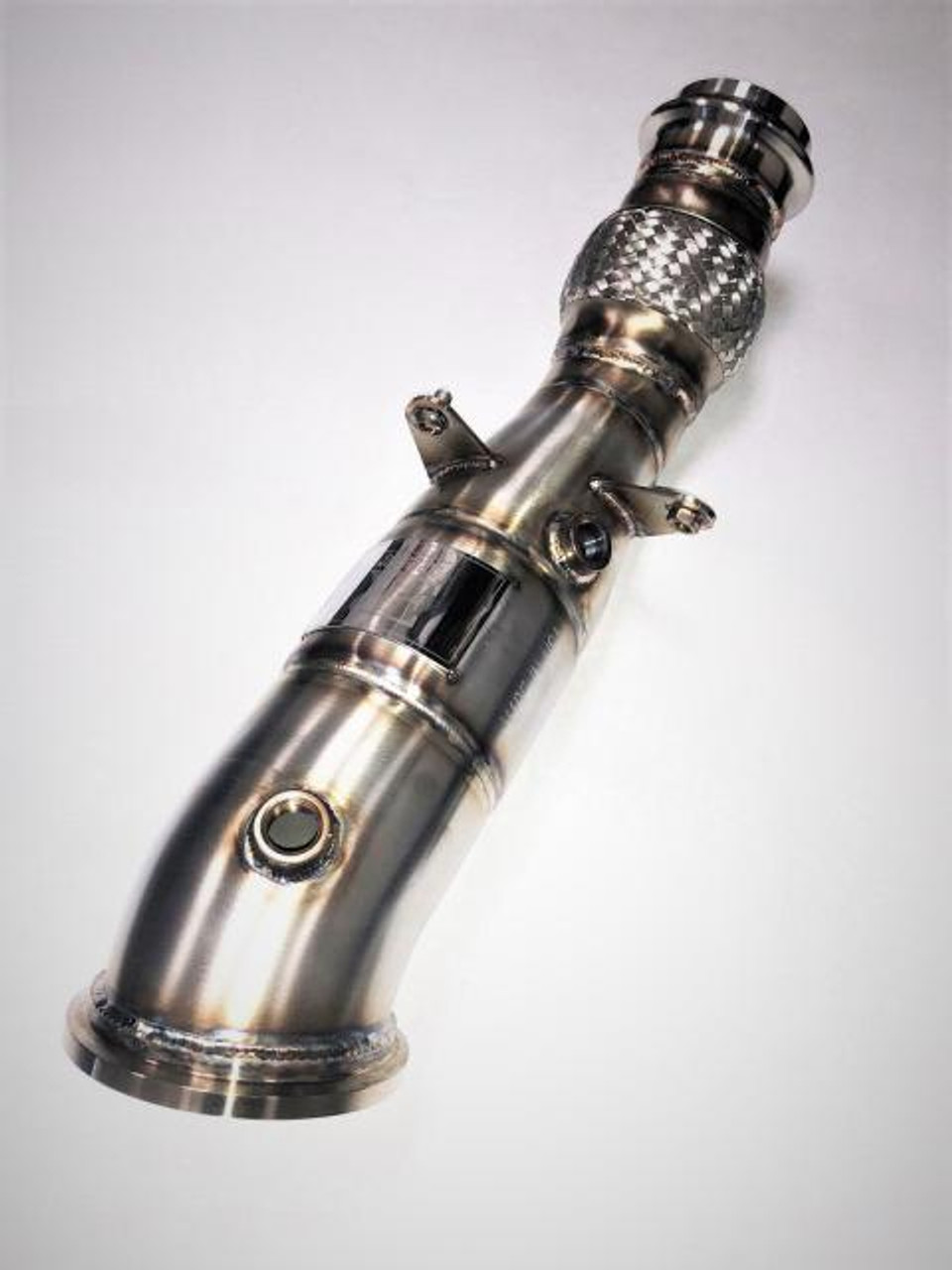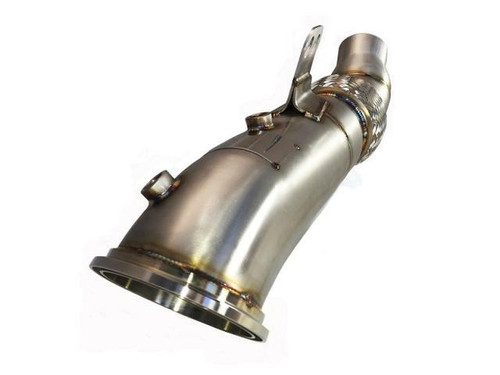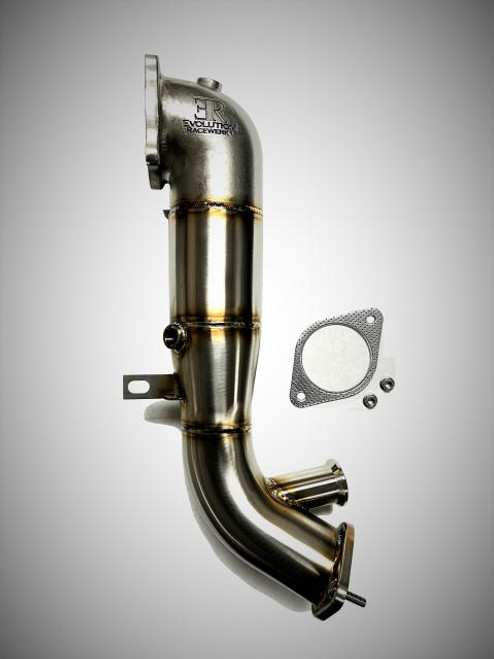Product Description
Evolution Racewerks High Flow Catted Downpipe 2020+ Toyota Supra B46 2.0L TO-EXH002CAT
Introducing our new Sports Series 4" High Flow Metallic Catted Downpipes for your 2020+ Toyota Supra 2.0 B46 four cylinder turbo engine! The B46 engine is found in all U.S. spec cars. The downpipe is different than the B48 found in the EU / Asia spec cars. You must get the correct downpipe for your car as they are not interchangeable.
|
Shown in Brush Finish |
Ease of Installation: (1 Easy, 5 Hard) 3
Installation Guide
Parts Checklist
Key Features:
- Now available for the 2020+ Toyota Supra 2.0 B46 Engine!
- High Flow 200 cell metallic catalytic converter used
- Horsepower gains of 9 to 11 whp average (gains will vary based on modifications of your vehicle).
- Higher Max Horsepower Power Curve
- Torque gains of 15 wtq average (stock boost) up to over 20 wtq (Software upgrade) (gains will vary based on modifications of your vehicle).
- Higher Intial Torque Curve. Torque curve hits faster and higher and longer.
- Better throttle response and faster turbo spool up times.
- Mandrel Bent 4" piping. Smooth transition to the exhaust system.
- 100% Stainless Steel Construction
- 100% TIG welded for better quality welds
- Precision CNC machined turbocharger V-Band flange.
- Precision CNC machined ball joint flange with straight flow interior (versus factory press formed ball joint)
- Stainless steel flex section like factory that allows proper exhaust movement and flexibility.
- Mirror polish or brush finish
- Available with high temperature black thermal coating to reduce underhood temperatures.
- Optional - Additional O2 sensor bung for wideband O2 sensors (comes with pre-installed plug)
- Optional EGT sensor bung for EGT gauges (comes with pre-installed plug)
- Retains the factory "ball" type v-band connector.
- Improved design of "ball" connector for better flow characteristics over factory connector.
- Compatible with the factory or aftermarket exhaust systems.
- Track tested durability.
- Includes all hardware for complete installation.
- Limited Lifetime Warranty.
- Made in the USA!
|
Shown in Brush Finish |
Restrictions in the exhaust system robs horsepower and torque especially on turbocharged cars. Thus, removing as much exhaust flow restrictions will increase horsepower and torque significantly. The factory catalytic converter found in the factory downpipe is a big culprit of this and is a major exhaust flow restriction. The factory catalytic converter is made up of catalyst material formed into "honeycomb" weaves. Exhaust gas must pass through these tiny "honeycomb" weaves on their way to the exhaust system thus causing a major exhaust flow restriction. It also causes turbulence after the catalytic converter which causes the exhaust flow to slow down (which increases restriction). By replacing the factory downpipe/catalytic converter with our Sports Series 4" High Flow Metallic Catted Downpipe, more power is unleashed!
The factory catalyter uses a 900 cell ceramic core. What the 900 cells means is that per every inch, there are 900 "cells" that the exhaust gas must pass through. We use a 200 cell metallic core. By having less cells per square inch, these individual "cells" are bigger in size thus allowing exhaust gas to pass through it more easily. Thus, the lower the cell count, the higher the flow. Higher flow = more power, faster turbo spool up (less turbocharger lag) and better throttle response. Bottom line, faster. The benefits of a metallic catalytic converter vs a ceramic like the factory is that it can take higher temperatures and is more durable (last longer). They are also lighter than their ceramic counterparts.
|
200 Cell Metallic Catalytic Converter Element |
Our Sports Series 4" High Flow Catted Downpipes is constructed out of 100% 304 grade stainless steel and utilize mandrel bent piping. They are 100% TIG welded by our in house fabricators and built in the USA. The factory turbocharger turbine housing utilizes a 4" V-Band flange which we have duplicated and CNC machined cut out of billet 304 stainless steel. Stainless Steel CNC machined O2 sensor and laser cut brackets are TIG welded using stainless steel rods. The O2 sensor is positioned at the factory location. Since the outlet of the turbocharger is 4" and the factory exhaust system is 3", the factory downpipes reduces size using short transitions from 4" before the catalytic convert and 3" afterwards. Due to space needed for the cataylic converter, the factory downpipes reduce in size using very short transitions. Since our catless downpipes delete the cataylic converter, we have more space. Thus, we use very long transitions. These longer transitions allow the exhaust gas time to smoothly transition from the larger piping to the smaller. This results in less exhaust turbulence and backpressure which again improves throttle response and increase turbocharger spool times (less turbocharger lag).
The factory downpipe utilizes a flex bellow section that allows the exhaust system to move. This eliminates undue stress on the exhaust components like the exhaust system, downpipe, turbocharger and exhaust manifold. Many of our competitors do not feel it is important to keep this. While you do not see any adverse affects right away, over time, the stresses caused by not having a flex section and having a rigid exhaust system will cause premature wear and tear. Any stress failures like cracks will form quicker than usual on exhaust manifolds and exhaust components. Also, without a flex section, the exhaust system cannot properly deflect impact. Especially on lowered cars, whenever the exhaust system contacts the ground, the entire system gets pushed up. Without a flex, you can imagine how much stress is put into exhaust components like the exhaust manifold when the exhaust is pushed upwards. We fully understand that durability of our products is important. Thus, like BMW, we incorporate a flex section into our downpipe. Our flex sections are 100% stainless steel (cheap flex sections only have stainless steel center braids and steel caps) to ensure corrosion resistance.
|
CNC Machined Solid Billet Ball Joint & Stainless Steel Flex Section |
One of the main features of our B46/B48 downpipe is the CNC machined solid stainless steel billet ball joint. The factory downpipe uses a press formed process to produce the "ball" joint to connect to the factory exhaust. This process can be done very inexpensively when done in large productions runs. Unfortunately, the drawback of this press formed "ball" joint is that the interior of the pipe also mimics the outside. When exhaust flows through a pipe, the majority of the exhaust flow tends to stay on the outer edges of the pipe. Thus, when exhaust flows into the "ball" section, it goes into the valley created by the "ball" joint and then back up the other side. This creates tremedous amounts of turbulence in the exhaust flow right at that section. Turbulence in turn, slows down exhaust flow velocities as well as increase back-pressure. It's a well known fact that with turbocharged cars, you want the least amount of back-pressure while still maintaining high exhaust flow velocities. Why? Because low back-pressure and high velocities allow the turbocharger to spin faster. This equates to reducing turbocharger lag and faster spool times. Throttle response is also improved. We had originally thought to use the same press form process to manufacture our downpipes. However, very quickly we noticed this flaw to the process and decided to CNC a solid stainless steel billet "ball" joint. This allowed us to keep the factory connection while keeping the interior of the ball smooth. This allows the exhaust to flow unrestricted through the "ball" joint. While this CNC solid stainless steel billet was very expensive to manufacturer, our motto at ER is "Performance, no compromises". Our in house testing showed that we did indeed have real world improvements with this new CNC billet "ball" joint and thus worth the extra costs. This is why the N26 downpipes do cost a little bit more than the N20 downpipes as the N20 downpipes do not have the ball joint system but use a traditional slip-fit design which is cheaper for us to manufacturer. The pictures below show the factory "ball" joint cut in half (to show in the interior) versus our CNC solid stainless steel billet "ball" joint.
Since we are able to reproduce the factory "ball" joint v-band connector, our downpipes are designed to fit perfectly with either the factory exhaust system or your aftermarket exhaust system. There are no compatibility issues whatsover. The downpipes will come by default with brushed finish.
BUILD DATE
From 09/2020 and on build date cars, BMW changed the downpipe bracket location. The 09/2020+ models have one downpipe bracket on top and one on the very bottom. The 2016 to 08/2020 build date had one downpipe bracket on top and one on the side. You need to select the correct build date to ensure you have the correct downpipe bracket alignments. If you are unsure about which version you need, feel free to contact us at contact@evolutionracewerks.com or call us at 626-334-6609 and we can help you find out which version you need.











